高并发系统有三把利器:缓存、降级和限流;
限流的目的是通过对并发访问/请求进行限速来保护系统,一旦达到限制速率则可以拒绝服务(定向到错误页)、排队等待(秒杀)、降级(返回兜底数据或默认数据);
高并发系统常见的限流有:限制总并发数(数据库连接池)、限制瞬时并发数(如nginx的limit_conn模块,用来限制瞬时并发连接数)、限制时间窗口内的平均速率(nginx的limit_req模块,用来限制每秒的平均速率);
另外还可以根据网络连接数、网络流量、CPU或内存负载等来限流。
1.限流算法
最简单粗暴的限流算法就是计数器法了,而比较常用的有漏桶算法和令牌桶算法;
1.1计数器
计数器法是限流算法里最简单也是最容易实现的一种算法。比如我们规定,对于A接口来说,我们1分钟的访问次数不能超过100个。
那么我们我们可以设置一个计数器counter,其有效时间为1分钟(即每分钟计数器会被重置为0),每当一个请求过来的时候,counter就加1,如果counter的值大于100,就说明请求数过多;
这个算法虽然简单,但是有一个十分致命的问题,那就是临界问题。
如下图所示,在1:00前一刻到达100个请求,1:00计数器被重置,1:00后一刻又到达100个请求,显然计数器不会超过100,所有请求都不会被拦截;
然而这一时间段内请求数已经达到200,远超100。

1.2 漏桶算法
如下图所示,有一个固定容量的漏桶,按照常量固定速率流出水滴;如果桶是空的,则不会流出水滴;流入到漏桶的水流速度是随意的;如果流入的水超出了桶的容量,则流入的水会溢出(被丢弃);
可以看到漏桶算法天生就限制了请求的速度,可以用于流量整形和限流控制;
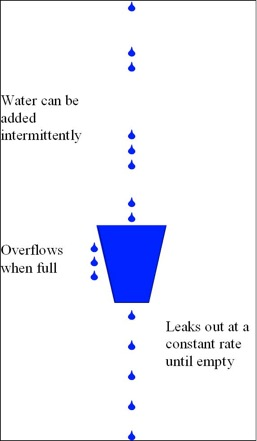
1.3 令牌桶算法
令牌桶是一个存放固定容量令牌的桶,按照固定速率r往桶里添加令牌;桶中最多存放b个令牌,当桶满时,新添加的令牌被丢弃;
当一个请求达到时,会尝试从桶中获取令牌;如果有,则继续处理请求;如果没有则排队等待或者直接丢弃;
可以发现,漏桶算法的流出速率恒定或者为0,而令牌桶算法的流出速率却有可能大于r;

2.nginx基础知识
Nginx主要有两种限流方式:按连接数限流(ngx_http_limit_conn_module)、按请求速率限流(ngx_http_limit_req_module);
学习限流模块之前还需要了解nginx对HTTP请求的处理过程,nginx事件处理流程等;
2.1HTTP请求处理过程
nginx将HTTP请求处理流程分为11个阶段,绝大多数HTTP模块都会将自己的handler添加到某个阶段(其中有4个阶段不能添加自定义handler),nginx处理HTTP请求时会挨个调用所有的handler;
typedef enum {
NGX_HTTP_POST_READ_PHASE = 0, //目前只有realip模块会注册handler(nginx作为代理服务器时有用,后端以此获取客户端原始ip)
NGX_HTTP_SERVER_REWRITE_PHASE, //server块中配置了rewrite指令,重写url
NGX_HTTP_FIND_CONFIG_PHASE, //查找匹配location;不能自定义handler;
NGX_HTTP_REWRITE_PHASE, //location块中配置了rewrite指令,重写url
NGX_HTTP_POST_REWRITE_PHASE, //检查是否发生了url重写,如果有,重新回到FIND_CONFIG阶段;不能自定义handler;
NGX_HTTP_PREACCESS_PHASE, //访问控制,限流模块会注册handler到此阶段
NGX_HTTP_ACCESS_PHASE, //访问权限控制
NGX_HTTP_POST_ACCESS_PHASE, //根据访问权限控制阶段做相应处理;不能自定义handler;
NGX_HTTP_TRY_FILES_PHASE, //只有配置了try_files指令,才会有此阶段;不能自定义handler;
NGX_HTTP_CONTENT_PHASE, //内容产生阶段,返回响应给客户端
NGX_HTTP_LOG_PHASE //日志记录
} ngx_http_phases;
nginx使用结构体ngx_module_s表示一个模块,其中字段ctx,是一个指向模块上下文结构体的指针;nginx的HTTP模块上下文结构体如下所示(上下文结构体的字段都是一些函数指针):
typedef struct {
ngx_int_t (*preconfiguration)(ngx_conf_t *cf);
ngx_int_t (*postconfiguration)(ngx_conf_t *cf); //此方法注册handler到相应阶段
void *(*create_main_conf)(ngx_conf_t *cf); //http块中的主配置
char *(*init_main_conf)(ngx_conf_t *cf, void *conf);
void *(*create_srv_conf)(ngx_conf_t *cf); //server配置
char *(*merge_srv_conf)(ngx_conf_t *cf, void *prev, void *conf);
void *(*create_loc_conf)(ngx_conf_t *cf); //location配置
char *(*merge_loc_conf)(ngx_conf_t *cf, void *prev, void *conf);
} ngx_http_module_t;
以ngx_http_limit_req_module模块为例,postconfiguration方法简单实现如下:
static ngx_int_t ngx_http_limit_req_init(ngx_conf_t *cf)
{
h = ngx_array_push(&cmcf->phases[NGX_HTTP_PREACCESS_PHASE].handlers);
*h = ngx_http_limit_req_handler; //ngx_http_limit_req_module模块的限流方法;nginx处理HTTP请求时,都会调用此方法判断应该继续执行还是拒绝请求
return NGX_OK;
}
2.2 nginx事件处理简单介绍
假设nginx使用的是epoll。
nginx需要将所有关心的fd注册到epoll,添加方法生命如下:
static ngx_int_t ngx_epoll_add_event(ngx_event_t *ev, ngx_int_t event, ngx_uint_t flags);
方法第一个参数是ngx_event_t结构体指针,代表关心的一个读或者写事件;nginx为事件可能会设置一个超时定时器,从而能够处理事件超时情况;定义如下:
struct ngx_event_s {
ngx_event_handler_pt handler; //函数指针:事件的处理函数
ngx_rbtree_node_t timer; //超时定时器,存储在红黑树中(节点的key即为事件的超时时间)
unsigned timedout:1; //记录事件是否超时
};
一般都会循环调用epoll_wait监听所有fd,处理发生的读写事件;epoll_wait是阻塞调用,最后一个参数timeout是超时时间,即最多阻塞timeout时间如果还是没有事件发生,方法会返回;
nginx在设置超时时间timeout时,会从上面说的记录超时定时器的红黑树中查找最近要到时的节点,以此作为epoll_wait的超时时间,如下面代码所示;
ngx_msec_t ngx_event_find_timer(void)
{
node = ngx_rbtree_min(root, sentinel);
timer = (ngx_msec_int_t) (node->key - ngx_current_msec);
return (ngx_msec_t) (timer > 0 ? timer : 0);
}
同时nginx在每次循环的最后,会从红黑树中查看是否有事件已经过期,如果过期,标记timeout=1,并调用事件的handler;
void ngx_event_expire_timers(void)
{
for ( ;; ) {
node = ngx_rbtree_min(root, sentinel);
if ((ngx_msec_int_t) (node->key - ngx_current_msec) <= 0) { //当前事件已经超时
ev = (ngx_event_t *) ((char *) node - offsetof(ngx_event_t, timer));
ev->timedout = 1;
ev->handler(ev);
continue;
}
break;
}
}
nginx就是通过上面的方法实现了socket事件的处理,定时事件的处理;
ngx_http_limit_req_module模块解析
ngx_http_limit_req_module模块是对请求进行限流,即限制某一时间段内用户的请求速率;且使用的是令牌桶算法;
3.1配置指令
ngx_http_limit_req_module模块提供一下配置指令,供用户配置限流策略
//每个配置指令主要包含两个字段:名称,解析配置的处理方法
static ngx_command_t ngx_http_limit_req_commands[] = {
//一般用法:limit_req_zone $binary_remote_addr zone=one:10m rate=1r/s;
//$binary_remote_addr表示远程客户端IP;
//zone配置一个存储空间(需要分配空间记录每个客户端的访问速率,超时空间限制使用lru算法淘汰;注意此空间是在共享内存分配的,所有worker进程都能访问)
//rate表示限制速率,此例为1qps
{ ngx_string("limit_req_zone"),
ngx_http_limit_req_zone,
},
//用法:limit_req zone=one burst=5 nodelay;
//zone指定使用哪一个共享空间
//超出此速率的请求是直接丢弃吗?burst配置用于处理突发流量,表示最大排队请求数目,当客户端请求速率超过限流速率时,请求会排队等待;而超出burst的才会被直接拒绝;
//nodelay必须与burst一起使用;此时排队等待的请求会被优先处理;否则假如这些请求依然按照限流速度处理,可能等到服务器处理完成后,客户端早已超时
{ ngx_string("limit_req"),
ngx_http_limit_req,
},
//当请求被限流时,日志记录级别;用法:limit_req_log_level info | notice | warn | error;
{ ngx_string("limit_req_log_level"),
ngx_conf_set_enum_slot,
},
//当请求被限流时,给客户端返回的状态码;用法:limit_req_status 503
{ ngx_string("limit_req_status"),
ngx_conf_set_num_slot,
},
};
注意:$binary_remote_addr是nginx提供的变量,用户在配置文件中可以直接使用;nginx还提供了许多变量,在ngx_http_variable.c文件中查找ngx_http_core_variables数组即可:
static ngx_http_variable_t ngx_http_core_variables[] = {
{ ngx_string("http_host"), NULL, ngx_http_variable_header,
offsetof(ngx_http_request_t, headers_in.host), 0, 0 },
{ ngx_string("http_user_agent"), NULL, ngx_http_variable_header,
offsetof(ngx_http_request_t, headers_in.user_agent), 0, 0 },
…………
}
3.2源码解析
ngx_http_limit_req_module在postconfiguration过程会注册ngx_http_limit_req_handler方法到HTTP处理的NGX_HTTP_PREACCESS_PHASE阶段;
ngx_http_limit_req_handler会执行漏桶算法,判断是否超出配置的限流速率,从而进行丢弃或者排队或者通过;
当用户第一次请求时,会新增一条记录(主要记录访问计数、访问时间),以客户端IP地址(配置$binary_remote_addr)的hash值作为key存储在红黑树中(快速查找),同时存储在LRU队列中(存储空间不够时,淘汰记录,每次都是从尾部删除);当用户再次请求时,会从红黑树中查找这条记录并更新,同时移动记录到LRU队列首部;
3.2.1数据结构
limit_req_zone配置限流算法所需的存储空间(名称及大小),限流速度,限流变量(客户端IP等),结构如下:
typedef struct {
ngx_http_limit_req_shctx_t *sh;
ngx_slab_pool_t *shpool;//内存池
ngx_uint_t rate; //限流速度(qps乘以1000存储)
ngx_int_t index; //变量索引(nginx提供了一系列变量,用户配置的限流变量索引)
ngx_str_t var; //限流变量名称
ngx_http_limit_req_node_t *node;
} ngx_http_limit_req_ctx_t;
//同时会初始化共享存储空间
struct ngx_shm_zone_s {
void *data; //data指向ngx_http_limit_req_ctx_t结构
ngx_shm_t shm; //共享空间
ngx_shm_zone_init_pt init; //初始化方法函数指针
void *tag; //指向ngx_http_limit_req_module结构体
};
limit_req配置限流使用的存储空间,排队队列大小,是否紧急处理,结构如下:
typedef struct {
ngx_shm_zone_t *shm_zone; //共享存储空间
ngx_uint_t burst; //队列大小
ngx_uint_t nodelay; //有请求排队时是否紧急处理,与burst配合使用(如果配置,则会紧急处理排队请求,否则依然按照限流速度处理)
} ngx_http_limit_req_limit_t;
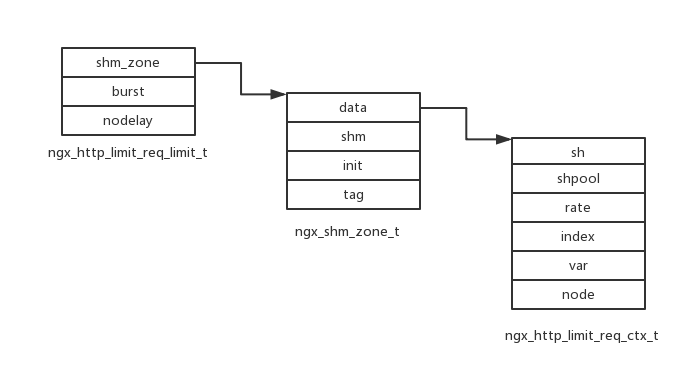
前面说过用户访问记录会同时存储在红黑树与LRU队列中,结构如下:
//记录结构体
typedef struct {
u_char color;
u_char dummy;
u_short len; //数据长度
ngx_queue_t queue;
ngx_msec_t last; //上次访问时间
ngx_uint_t excess; //当前剩余待处理的请求数(nginx用此实现令牌桶限流算法)
ngx_uint_t count; //此类记录请求的总数
u_char data[1];//数据内容(先按照key(hash值)查找,再比较数据内容是否相等)
} ngx_http_limit_req_node_t;
//红黑树节点,key为用户配置限流变量的hash值;
struct ngx_rbtree_node_s {
ngx_rbtree_key_t key;
ngx_rbtree_node_t *left;
ngx_rbtree_node_t *right;
ngx_rbtree_node_t *parent;
u_char color;
u_char data;
};
typedef struct {
ngx_rbtree_t rbtree; //红黑树
ngx_rbtree_node_t sentinel; //NIL节点
ngx_queue_t queue; //LRU队列
} ngx_http_limit_req_shctx_t;
//队列只有prev和next指针
struct ngx_queue_s {
ngx_queue_t *prev;
ngx_queue_t *next;
};
思考1:ngx_http_limit_req_node_t记录通过prev和next指针形成双向链表,实现LRU队列;最新访问的节点总会被插入链表头部,淘汰时从尾部删除节点;
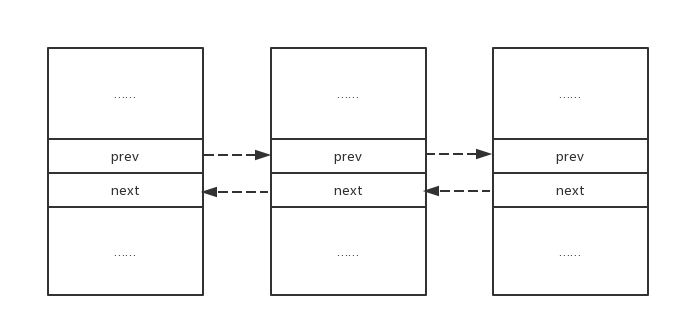
ngx_http_limit_req_ctx_t *ctx;
ngx_queue_t *q;
q = ngx_queue_last(&ctx->sh->queue);
lr = ngx_queue_data(q, ngx_http_limit_req_node_t, queue);//此方法由ngx_queue_t获取ngx_http_limit_req_node_t结构首地址,实现如下:
#define ngx_queue_data(q, type, link) (type *) ((u_char *) q - offsetof(type, link)) //queue字段地址减去其在结构体中偏移,为结构体首地址
思考2:限流算法首先使用key查找红黑树节点,从而找到对应的记录,红黑树节点如何与记录ngx_http_limit_req_node_t结构关联起来呢?在ngx_http_limit_req_module模块可以找到以代码:
size = offsetof(ngx_rbtree_node_t, color) //新建记录分配内存,计算所需空间大小
+ offsetof(ngx_http_limit_req_node_t, data)
+ len;
node = ngx_slab_alloc_locked(ctx->shpool, size);
node->key = hash;
lr = (ngx_http_limit_req_node_t *) &node->color; //color为u_char类型,为什么能强制转换为ngx_http_limit_req_node_t指针类型呢?
lr->len = (u_char) len;
lr->excess = 0;
ngx_memcpy(lr->data, data, len);
ngx_rbtree_insert(&ctx->sh->rbtree, node);
ngx_queue_insert_head(&ctx->sh->queue, &lr->queue);
通过分析上面代码,ngx_rbtree_node_s结构体的color与data字段其实是无意义的,结构体的生命形式与最终存储形式是不同的,nginx最终使用以下存储形式存储每条记录;
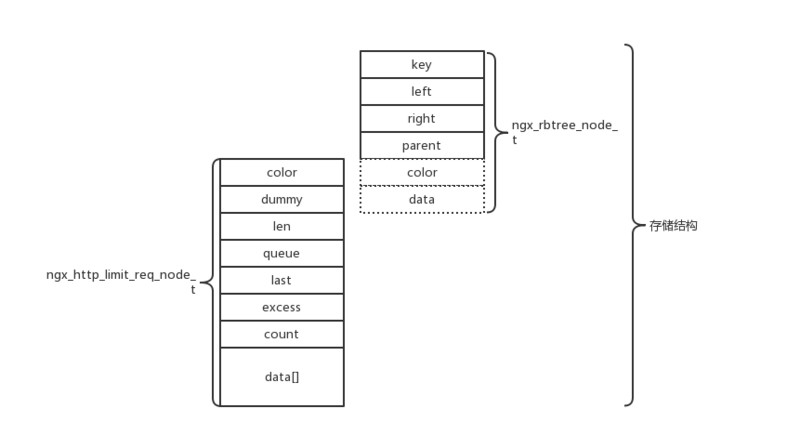
3.2.2限流算法
上面提到在postconfiguration过程会注册ngx_http_limit_req_handler方法到HTTP处理的NGX_HTTP_PREACCESS_PHASE阶段;
因此在处理HTTP请求时,会执行ngx_http_limit_req_handler方法判断是否需要限流;
3.2.2.1漏桶算法实现
用户可能同时配置若干限流,因此对于HTTP请求,nginx需要遍历所有限流策略,判断是否需要限流;
ngx_http_limit_req_lookup方法实现了漏桶算法,方法返回3种结果:
- NGX_BUSY:请求速率超出限流配置,拒绝请求;
- NGX_AGAIN:请求通过了当前限流策略校验,继续校验下一个限流策略;
- NGX_OK:请求已经通过了所有限流策略的校验,可以执行下一阶段;
- NGX_ERROR:出错
//limit,限流策略;hash,记录key的hash值;data,记录key的数据内容;len,记录key的数据长度;ep,待处理请求数目;account,是否是最后一条限流策略
static ngx_int_t ngx_http_limit_req_lookup(ngx_http_limit_req_limit_t *limit, ngx_uint_t hash, u_char *data, size_t len, ngx_uint_t *ep, ngx_uint_t account)
{
//红黑树查找指定界定
while (node != sentinel) {
if (hash < node->key) {
node = node->left;
continue;
}
if (hash > node->key) {
node = node->right;
continue;
}
//hash值相等,比较数据是否相等
lr = (ngx_http_limit_req_node_t *) &node->color;
rc = ngx_memn2cmp(data, lr->data, len, (size_t) lr->len);
//查找到
if (rc == 0) {
ngx_queue_remove(&lr->queue);
ngx_queue_insert_head(&ctx->sh->queue, &lr->queue); //将记录移动到LRU队列头部
ms = (ngx_msec_int_t) (now - lr->last); //当前时间减去上次访问时间
excess = lr->excess - ctx->rate * ngx_abs(ms) / 1000 + 1000; //待处理请求书-限流速率*时间段+1个请求(速率,请求数等都乘以1000了)
if (excess < 0) {
excess = 0;
}
*ep = excess;
//待处理数目超过burst(等待队列大小),返回NGX_BUSY拒绝请求(没有配置burst时,值为0)
if ((ngx_uint_t) excess > limit->burst) {
return NGX_BUSY;
}
if (account) { //如果是最后一条限流策略,则更新上次访问时间,待处理请求数目,返回NGX_OK
lr->excess = excess;
lr->last = now;
return NGX_OK;
}
//访问次数递增
lr->count++;
ctx->node = lr;
return NGX_AGAIN; //非最后一条限流策略,返回NGX_AGAIN,继续校验下一条限流策略
}
node = (rc < 0) ? node->left : node->right;
}
//假如没有查找到节点,需要新建一条记录
*ep = 0;
//存储空间大小计算方法参照3.2.1节数据结构
size = offsetof(ngx_rbtree_node_t, color)
+ offsetof(ngx_http_limit_req_node_t, data)
+ len;
//尝试淘汰记录(LRU)
ngx_http_limit_req_expire(ctx, 1);
node = ngx_slab_alloc_locked(ctx->shpool, size);//分配空间
if (node == NULL) { //空间不足,分配失败
ngx_http_limit_req_expire(ctx, 0); //强制淘汰记录
node = ngx_slab_alloc_locked(ctx->shpool, size); //分配空间
if (node == NULL) { //分配失败,返回NGX_ERROR
return NGX_ERROR;
}
}
node->key = hash; //赋值
lr = (ngx_http_limit_req_node_t *) &node->color;
lr->len = (u_char) len;
lr->excess = 0;
ngx_memcpy(lr->data, data, len);
ngx_rbtree_insert(&ctx->sh->rbtree, node); //插入记录到红黑树与LRU队列
ngx_queue_insert_head(&ctx->sh->queue, &lr->queue);
if (account) { //如果是最后一条限流策略,则更新上次访问时间,待处理请求数目,返回NGX_OK
lr->last = now;
lr->count = 0;
return NGX_OK;
}
lr->last = 0;
lr->count = 1;
ctx->node = lr;
return NGX_AGAIN; //非最后一条限流策略,返回NGX_AGAIN,继续校验下一条限流策略
}
举个例子,假如burst配置为0,待处理请求数初始为excess;令牌产生周期为T;如下图所示
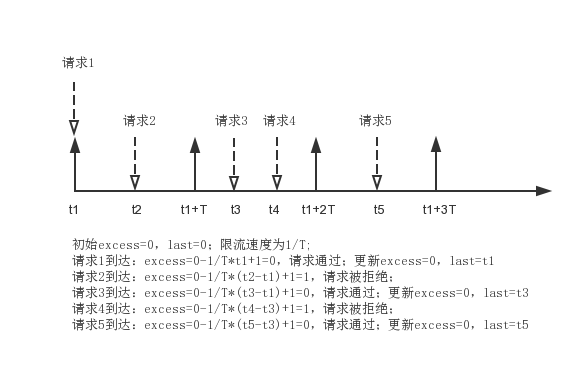
3.2.2.2LRU淘汰策略
上一节叩痛算法中,会执行ngx_http_limit_req_expire淘汰一条记录,每次都是从LRU队列末尾删除;
第二个参数n,当n==0时,强制删除末尾一条记录,之后再尝试删除一条或两条记录;n==1时,会尝试删除一条或两条记录;代码实现如下:
static void ngx_http_limit_req_expire(ngx_http_limit_req_ctx_t *ctx, ngx_uint_t n)
{
//最多删除3条记录
while (n < 3) {
//尾部节点
q = ngx_queue_last(&ctx->sh->queue);
//获取记录
lr = ngx_queue_data(q, ngx_http_limit_req_node_t, queue);
//注意:当为0时,无法进入if代码块,因此一定会删除尾部节点;当n不为0时,进入if代码块,校验是否可以删除
if (n++ != 0) {
ms = (ngx_msec_int_t) (now - lr->last);
ms = ngx_abs(ms);
//短时间内被访问,不能删除,直接返回
if (ms < 60000) {
return;
}
//有待处理请求,不能删除,直接返回
excess = lr->excess - ctx->rate * ms / 1000;
if (excess > 0) {
return;
}
}
//删除
ngx_queue_remove(q);
node = (ngx_rbtree_node_t *)
((u_char *) lr - offsetof(ngx_rbtree_node_t, color));
ngx_rbtree_delete(&ctx->sh->rbtree, node);
ngx_slab_free_locked(ctx->shpool, node);
}
}
3.2.2.3 burst实现
burst是为了应对突发流量的,偶然间的突发流量到达时,应该允许服务端多处理一些请求才行;
当burst为0时,请求只要超出限流速率就会被拒绝;当burst大于0时,超出限流速率的请求会被排队等待 处理,而不是直接拒绝;
排队过程如何实现?而且nginx还需要定时去处理排队中的请求;
2.2小节提到事件都有一个定时器,nginx是通过事件与定时器配合实现请求的排队与定时处理;
ngx_http_limit_req_handler方法有下面的代码:
//计算当前请求还需要排队多久才能处理
delay = ngx_http_limit_req_account(limits, n, &excess, &limit);
//添加可读事件
if (ngx_handle_read_event(r->connection->read, 0) != NGX_OK) {
return NGX_HTTP_INTERNAL_SERVER_ERROR;
}
r->read_event_handler = ngx_http_test_reading;
r->write_event_handler = ngx_http_limit_req_delay; //可写事件处理函数
ngx_add_timer(r->connection->write, delay); //可写事件添加定时器(超时之前是不能往客户端返回的)
计算delay的方法很简单,就是遍历所有的限流策略,计算处理完所有待处理请求需要的时间,返回最大值;
if (limits[n].nodelay) { //配置了nodelay时,请求不会被延时处理,delay为0
continue;
}
delay = excess * 1000 / ctx->rate;
if (delay > max_delay) {
max_delay = delay;
*ep = excess;
*limit = &limits[n];
}
简单看看可写事件处理函数ngx_http_limit_req_delay的实现
static void ngx_http_limit_req_delay(ngx_http_request_t *r)
{
wev = r->connection->write;
if (!wev->timedout) { //没有超时不会处理
if (ngx_handle_write_event(wev, 0) != NGX_OK) {
ngx_http_finalize_request(r, NGX_HTTP_INTERNAL_SERVER_ERROR);
}
return;
}
wev->timedout = 0;
r->read_event_handler = ngx_http_block_reading;
r->write_event_handler = ngx_http_core_run_phases;
ngx_http_core_run_phases(r); //超时了,继续处理HTTP请求
}
4.实战
4.1测试普通限流
1)配置nginx限流速率为1qps,针对客户端IP地址限流(返回状态码默认为503),如下:
http{
limit_req_zone $binary_remote_addr zone=test:10m rate=1r/s;
server {
listen 80;
server_name localhost;
location / {
limit_req zone=test;
root html;
index index.html index.htm;
}
}
2)连续并发发起若干请求;3)查看服务端access日志,可以看到22秒连续到达3个请求,只处理1个请求;23秒到达两个请求,第一个请求处理,第二个请求被拒绝
xx.xx.xx.xxx - - [22/Sep/2018:23:33:22 +0800] "GET / HTTP/1.0" 200 612 "-" "ApacheBench/2.3"
xx.xx.xx.xxx - - [22/Sep/2018:23:33:22 +0800] "GET / HTTP/1.0" 503 537 "-" "ApacheBench/2.3"
xx.xx.xx.xxx - - [22/Sep/2018:23:33:22 +0800] "GET / HTTP/1.0" 503 537 "-" "ApacheBench/2.3"
xx.xx.xx.xxx - - [22/Sep/2018:23:33:23 +0800] "GET / HTTP/1.0" 200 612 "-" "ApacheBench/2.3"
xx.xx.xx.xxx - - [22/Sep/2018:23:33:23 +0800] "GET / HTTP/1.0" 503 537 "-" "ApacheBench/2.3"
4.2测试burst
1)限速1qps时,超过请求会被直接拒绝,为了应对突发流量,应该允许请求被排队处理;因此配置burst=5,即最多允许5个请求排队等待处理;
http{
limit_req_zone $binary_remote_addr zone=test:10m rate=1r/s;
server {
listen 80;
server_name localhost;
location / {
limit_req zone=test burst=5;
root html;
index index.html index.htm;
}
}
2)使用ab并发发起10个请求,ab -n 10 -c 10 http://xxxxx;
3)查看服务端access日志;根据日志显示第一个请求被处理,2到5四个请求拒绝,6到10五个请求被处理;为什么会是这样的结果呢?
查看ngx_http_log_module,注册handler到NGX_HTTP_LOG_PHASE阶段(HTTP请求处理最后一个阶段);
因此实际情况应该是这样的:10个请求同时到达,第一个请求到达直接被处理,第2到6个请求到达,排队延迟处理(每秒处理一个);第7到10个请求被直接拒绝,因此先打印access日志;
第2到6个请求米诶秒处理一个,处理完成打印access日志,即49到53秒每秒处理一个;
xx.xx.xx.xxx - - [22/Sep/2018:23:41:48 +0800] "GET / HTTP/1.0" 200 612 "-" "ApacheBench/2.3"
xx.xx.xx.xxx - - [22/Sep/2018:23:41:48 +0800] "GET / HTTP/1.0" 503 537 "-" "ApacheBench/2.3"
xx.xx.xx.xxx - - [22/Sep/2018:23:41:48 +0800] "GET / HTTP/1.0" 503 537 "-" "ApacheBench/2.3"
xx.xx.xx.xxx - - [22/Sep/2018:23:41:48 +0800] "GET / HTTP/1.0" 503 537 "-" "ApacheBench/2.3"
xx.xx.xx.xxx - - [22/Sep/2018:23:41:48 +0800] "GET / HTTP/1.0" 503 537 "-" "ApacheBench/2.3"
xx.xx.xx.xxx - - [22/Sep/2018:23:41:49 +0800] "GET / HTTP/1.0" 200 612 "-" "ApacheBench/2.3"
xx.xx.xx.xxx - - [22/Sep/2018:23:41:50 +0800] "GET / HTTP/1.0" 200 612 "-" "ApacheBench/2.3"
xx.xx.xx.xxx - - [22/Sep/2018:23:41:51 +0800] "GET / HTTP/1.0" 200 612 "-" "ApacheBench/2.3"
xx.xx.xx.xxx - - [22/Sep/2018:23:41:52 +0800] "GET / HTTP/1.0" 200 612 "-" "ApacheBench/2.3"
xx.xx.xx.xxx - - [22/Sep/2018:23:41:53 +0800] "GET / HTTP/1.0" 200 612 "-" "ApacheBench/2.3"
4)ab统计的响应时间见下面,最小响应时间87ms,最大响应时间5128ms,平均响应时间为1609ms:
min mean[+/-sd] median max
Connect: 41 44 1.7 44 46
Processing: 46 1566 1916.6 1093 5084
Waiting: 46 1565 1916.7 1092 5084
Total: 87 1609 1916.2 1135 5128
4.3测试nodelay
1)4.2显示,配置burst后,虽然突发请求会被排队处理,但是响应时间过长,客户端可能早已超时;因此添加配置nodelay,使得nginx紧急处理等待请求,以减小响应时间:
http{
limit_req_zone $binary_remote_addr zone=test:10m rate=1r/s;
server {
listen 80;
server_name localhost;
location / {
limit_req zone=test burst=5 nodelay;
root html;
index index.html index.htm;
}
}
2)使用ab并发发起10个请求,ab -n 10 -c 10 http://xxxx/;
3)查看服务端access日志;第一个请求直接处理,第2到6个五个请求排队处理(配置nodelay,nginx紧急处理),第7到10四个请求被拒绝
xx.xx.xx.xxx - - [23/Sep/2018:00:04:47 +0800] "GET / HTTP/1.0" 200 612 "-" "ApacheBench/2.3"
xx.xx.xx.xxx - - [23/Sep/2018:00:04:47 +0800] "GET / HTTP/1.0" 200 612 "-" "ApacheBench/2.3"
xx.xx.xx.xxx - - [23/Sep/2018:00:04:47 +0800] "GET / HTTP/1.0" 200 612 "-" "ApacheBench/2.3"
xx.xx.xx.xxx - - [23/Sep/2018:00:04:47 +0800] "GET / HTTP/1.0" 200 612 "-" "ApacheBench/2.3"
xx.xx.xx.xxx - - [23/Sep/2018:00:04:47 +0800] "GET / HTTP/1.0" 200 612 "-" "ApacheBench/2.3"
xx.xx.xx.xxx - - [23/Sep/2018:00:04:47 +0800] "GET / HTTP/1.0" 200 612 "-" "ApacheBench/2.3"
xx.xx.xx.xxx - - [23/Sep/2018:00:04:47 +0800] "GET / HTTP/1.0" 503 537 "-" "ApacheBench/2.3"
xx.xx.xx.xxx - - [23/Sep/2018:00:04:47 +0800] "GET / HTTP/1.0" 503 537 "-" "ApacheBench/2.3"
xx.xx.xx.xxx - - [23/Sep/2018:00:04:47 +0800] "GET / HTTP/1.0" 503 537 "-" "ApacheBench/2.3"
xx.xx.xx.xxx - - [23/Sep/2018:00:04:47 +0800] "GET / HTTP/1.0" 503 537 "-" "ApacheBench/2.3"
4)ab统计的响应时间见下面,最小响应时间85ms,最大响应时间92ms,平均响应时间为88ms:
min mean[+/-sd] median max
Connect: 42 43 0.5 43 43
Processing: 43 46 2.4 47 49
Waiting: 42 45 2.5 46 49
Total: 85 88 2.8 90 92
总结
本文首先分析常用限流算法(漏桶算法与令牌桶算法),并简单介绍nginx处理HTTP请求的过程,nginx定时事件实现;然后详细分析ngx_http_limit_req_module模块的基本数据结构,及其限流过程;并以实例帮助读者体会nginx限流的配置及结果。至于另一个模块ngx_http_limit_conn_module是针对链接数的限流,比较容易理解,在此就不做详细介绍。
以上就是本文的全部内容,希望对大家的学习有所帮助,也希望大家多多支持脚本之家。